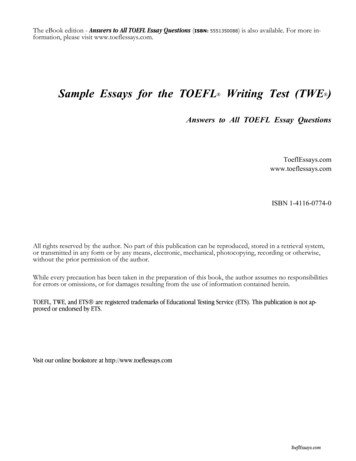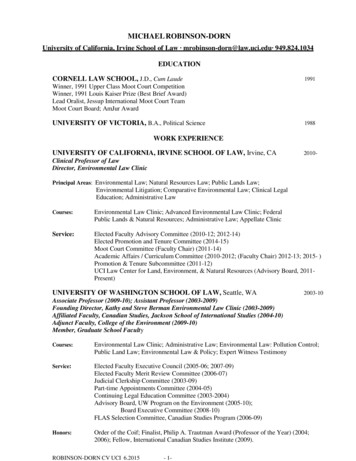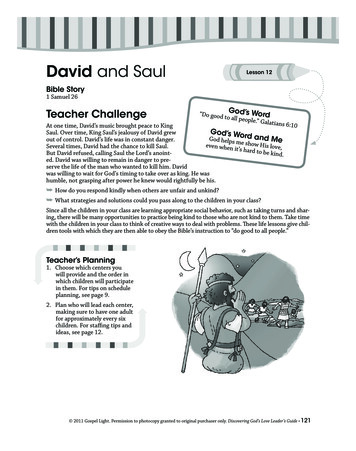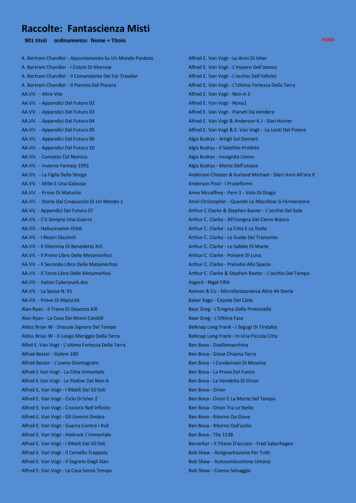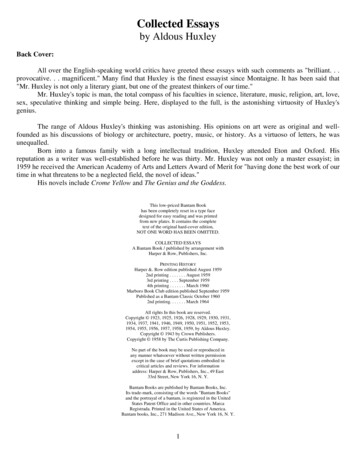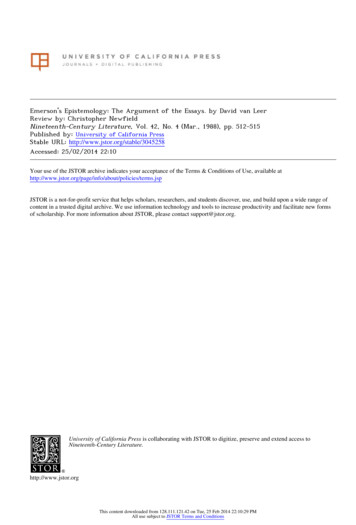
Transcription
Dorn, David. 2009. "Essays on Inequality, Spatial Interaction, andthe Demand for Skills." Dissertation University of St. Gallen no.3613, September.Data Appendix, pp. 121-138.
Thesis Appendix: DataContributionsA.1 Consistent Panel of OccupationsA.1.1 Census OccupationsThe United States Census records the detailed titles of workers’ occupations. Thepublicly available Census data aggregates this occupation information and reports severalhundred 3-digit occupation codes. Most of these occupation codes refer to narrow groupsof occupations, such as “chemical engineers” or “petroleum engineers” while residualcategories such as “engineers, n.e.c. (not elsewhere classified)” contain workers who couldnot be matched to a more detailed code. The occupational classification system getsredefined for every decennial Census. Changes to the occupation system often reflectthe growth and decline of specific occupations. For instance, “loom fixers” formed adetailed occupation code until 1970 but they were later integrated into the broader groupof “machinery maintenance occupations” as loom fixers’ importance in the labor marketdeclined. By contrast, a detailed occupation code for “speech therapists” was introducedonly in 1980. Before, these workers were classified among “therapists and healers, n.e.c.”.Appendix Table 1 lists the number of civilian occupations in each Census occupationsystem since 1950. The Census Bureau introduced ever more detailed occupation classifications between 1950 and 1980, thus almost doubling the number of reported occupationcodes from 268 to 504. Each of the subsequent data sets provides at least 465 occupationcodes. The two largest overhauls of the occupation system took place for the 1980 and2000 Censuses. In these years, the Census Bureau not only added new occupations butalso ceased using many detailed occupation categories that had been previously reported.The occupational classification schemes also sort detailed occupations into broaderoccupation groups. One of these broader groups of occupations is called “service occupations”. These jobs typically involve caring for, serving, or protecting others. AppendixTable 1 shows the number of service occupations in each Census occupation system since1950. The number of service occupation codes increased over time along with the overallgrowth in occupation codes. Furthermore, the 2000 Census slightly expanded the set of121
Appendix Table 1. Number of Occupations in the 1950-2000 Censuses and 2005 ACSNo. of occupationsNo. of service 19902682829532440445044450246Census2000 (5% ACS 2005Sample)4715946557Occupation counts include all civilian occupations. The 5% sample of the 2000 Census reports 34 feweroccupation codes than the 1% sample.occupations that are considered to be “service occupations” by including additional jobssuch as “gardeners and groundskeepers” or “movie picture projectionists”.In order to track detailed occupations over time, empirical work has to rely on crosswalks that match occupation codes from different Census years. Meyer and Osborne(2005) provide a carefully constructed crosswalk that matches occupations from the 19602000 Censuses to a system of 386 ‘occ1990 ’ occupation codes which are roughly based onthe 1990 Census occupation system. Due to the large similarity between occupations inthe 1950 and 1960 Censuses, the occ1990 system can readily be extended back to 1950.Furthermore, it can also be used for the 2005 American Community Survey which uses aslightly aggregated version of the 2000 Census occupation system.One limitation of the occ1990 system is that its occupation panel is unbalanced.For instance, there are no observations for the occ1990 category “economics instructors”in the 2000 Census. The specific fields of college teachers are no longer reported inthe 2000 Census and economics instructors therefore have to be included in the broaderocc1990 category “subject instructors, college”. This unbalanced panel structure wouldbe problematic for the empirical work in this thesis that studies employment or wagechanges within detailed occupations between 1980 and 2005.A.1.2 Occ1990dd Occupation SystemWe therefore developed a new occupation system with 330 ‘occ1990dd ’ codes thatprovides a balanced panel of occupations covering the 1980, 1990, and 2000 Censusesand the 2005 ACS. The balanced panel allows for the analysis of changes at the levelof detailed occupations between 1980 and 2005.29 Most occ1990dd codes result froma simple aggregation of occ1990 occupations, Moreover, the occ1990dd system makesa particular effort to provide consistent definitions of the detailed service occupationswhich are studied in the first essay of this thesis. Appendix Table 2 lists all occ1990ddoccupations and details the construction of occupation codes whose definitions differ from29We also experimented with an extension of the balanced panel back to the 1950 Census. Due tothe smaller number of occupations reported in the earlier Censuses and considerable changes in theoccupation system between 1970 and 1980, an extended balanced panel would be much less detailed.122
the occ1990 codes by Meyer and Osborne (2005).The occ1990dd codes can be aggregated into broader occupation groups. Broadergroups of occupations can be tracked quite well in every Census since 1950 even if somedetailed occupation codes are not reported for every year. For simplicity, we distinguishthe six major occupation groups that are reported in the 1990 Census on which the occ1990and occ1990dd occupation systems are based. The first of these groups is “managerialand professional specialty occupations” which covers most of the best paid occupationsin the labor market. “Technical, sales, and administrative support occupations” covera workforce that is on average better educated than any other occupation group apartfrom managers and professionals. The remaining four major occupation groups which allhave relatively low education levels are “service occupations”, “farming, forestry, and fishing occupations”, “precision production, craft, and repair occupations”, and “operators,fabricators, and laborers”.The designation of “service occupations” closely follows the updated and extendeddefinition that is used in the 2000 Census. The effort to identify a consistent set of serviceoccupations over time should mitigate the concern that the recent growth of employmentand wages in service occupations may be influenced by a changing definition of theseoccupations. Moreover, any spurious changes that may nevertheless be caused by the1980-2005 occupation crosswalk should be confined to the 1990-2000 period because theonly noteworthy changes to the Census occupation system since 1980 took place betweenthe 1990 and 2000 Censuses. The growth of service employment and wages does, however,also prevail in the 1980-1990 and 2000-2005 periods which are nearly unaffected by changesto occupational classification.A.1.3 Matching Task Data to OccupationsWe use job task data from the Dictionary of Occupational Titles (DOT; U. S. Department of Labor, Employment and Training Administration, 1977) to characterize the taskcontent of occupations. The DOT assesses the occupational tasks of more than 12,000highly detailed occupations. Our DOT data is based on an aggregation of these detailedoccupations to the three-digit occupation codes of the 1970 Census.30 The DOT taskscores are available for all but a few occupation codes. Occupations with missing taskdata are mostly residual categories like “miscellaneous operatives” or “clerical workers,not specified” that may cover workers whose Census forms provided imprecise occupational information. We impute task scores for these occupations by computing, e.g., thetask values for “professionals, not elsewhere classified” as the average task score of allprofessional occupations weighted by each occupation’s total work hours in 1970.The DOT 1977 task values are matched to occ1990dd occupation codes in several steps.30See Autor et al. (2003) for a more detailed description of this data.123
Appendix Table 2. "Occ1990dd" Occupation System, 1950-2005Balanced Panel 1980-2005Occ1990ddCodeOccupation Groups and Occupation sCensus1980CodesCensusCensus2000 (5%1990Sample)CodesCodesACS2005CodesA. Managerial and Professional Specialty OccupationsA.1 Executive, Administrative, and Managerial Occupations4Chief executives, public administrators, and legislators7Financial managers8Human resources and labor relations managers13Managers and specialists in marketing, advert., PR14Managers in education and related fields15Managers of medicine and health occupations18250270x3, 43, 41, 31xxxxxxxxxxxxxxxxxxxxxxxxxxManagers of properties and real estatexxxxxxx19Funeral directorsxxxxxxx22Managers and administrators, n.e.c.260, 290, 275, 280, 195, 201, 5, 17, 19 5, 16, 17, 2, 10, 11, 2, 10, 11,357290220, 22221, 2214, 22,14, 22,224, 245,30, 31,30, 31,24633, 34,33, 34,36, 40,36, 42,42, 43,43, 60,60, 7272A.2 Management Related Occupations23Accountants and auditors24Insurance underwritersxxxxxxxxxOther financial specialistsxxx26Management analystsxxxx27Personnel, HR, training, and labor rel. specialistsxxxx28Purchasing agents and buyers of farm productsxxxxxxx29Buyers, wholesale and retail tradexxxxxxx33Purchasing managers, agents, and buyers, n.e.c.xxxxxxx34Business and promotion agents35Construction inspectors36Inspectors and compliance officers, outsidet tiManagementsupport occupationsxxxx2537xxxxxxxxxxxxxxxxxxxxxA.3 Professional Specialty Occupations43Architectsxxxxxxx44Aerospace engineersxxxxxxx45Metallurgical and materials engineers47Petroleum, mining, and geological engineers4853xxxxxxx48912046, 4746, 47150, 152152Chemical engineersxxxxxxxCivil engineersxxxxxxx55Electrical engineersxxxxxxx56Industrial engineersxxxxxxx57Mechanical engineersxxxxxxx59Engineers and other professionals, n.e.c.49, 9993, 19523, 19649, 54,58, 5949, 54,58, 59124142, 144, 134, 142,150, 153 144, 150,153
Occ1990ddCodeOccupation Groups and Occupation sCensus1980CodesCensusCensus2000 (5%1990Sample)CodesCodesACS2005Codes64Computer systems analysts and computer scientistsxxxxx65Operations and systems researchers and analystsxxxxx66Actuaries68Mathematicians and statisticiansxxxxx67, 83135, 17435, 3667, 6867, 681241246973Physicists and astronomistsxxxxxxxChemistsxxxxxx74Atmospheric and space scientistsxxxxxx75Geologistsx76Physical scientists, n.e.c.xxxxxxxxxxxx77Agricultural and food scientistsxxxxxxxx7879Biological scientistsxxxxxxxForesters and conservation scientistsxxxxxx83Medical istsxxxxx89Other health and therapy occupations95Registered nurses96Pharmacists97Dieticians and nutritionists98Respiratory therapistsxxxx99Occupational therapists9999315315103Physical therapists103103316316104Speech therapistsxxxx105Therapists, n.e.c.xxxxxxxxxxxxx58, 59150, 15175, 40113-153113-153220220xxxxxxxxxxxxxxxxxxxxxx141, 145159159xxxxxxxxxxxxxxx106Physicians' assistants154Subject instructors, college155Kindergarten and earlier school teachers156Primary school teachers157Secondary school teachers158Special education teachers159Teachers, n.e.c.163Vocational and educational counselors164Librarians165Archivists and curators166Economists, market and survey researchersxxxxxxx167Psychologistsxxxxxxx169Social scientists and sociologists, n.e.c.52, 84102, 175186186173Urban and regional planners24, 26,92, 94xxxxx174Social workersxxxxxxx176Clergy and religious workersxxxxxxx177Welfare service workers467465202178Lawyers and judges5510530, 31183Writers and authorsxxx184Technical writers184xx954125168, 169 168, 169234, 255 234, 255178, 179 178, 179 210, 211202210xxxxxxxx
Occ1990ddCodeOccupation Groups and Occupation sCensus1980CodesCensusCensus2000 xxxxx186Musicians and composersxxxxxxx187Actors, directors, and producersxxxxxxx188Painters, sculptors, craft-artists, and rsxxxxxxx194Art/entertainment performers and related occsxxxxxxx195Editors and reportersxxxxxxx198Announcersxxxxx199Athletes, sports instructors, and officialsxxxxxxxxxB. Technical, Sales, and Administrative Support OccupationsB.1 Technicians and Related Support Occupations203Clinical laboratory technologies and techniciansxxxx204Dental hygienistsxxxxxx205Health record technologists and techniciansxxxxx206Radiologic technologists and techniciansxxxxx207Licensed practical nursesxxxxx208Health technologists and technicians, n.e.c.xxxxx214Engineering ryors, cartographers, mapping scientists/techsxx223224225Other science techniciansx226Airplane pilots and navigators154, 155, 213-216162xxxxxxxxxxBiological techniciansxxxxxChemical 0290227Air traffic controllers228Broadcast equipment operators229Computer software developersxxxxx233Programmers of numerically controlled machine toolsxxxxx234Legal assistants and paralegalsxxxx235Technicians, n.e.c.165, 173235235196196x96192xxB.2 Sales Occupations243Sales supervisors and proprietors253Insurance sales occupationsxxxxxxxx254Real estate sales occupationsxxxxxxxx255256Financial service sales occupationsxxxxxxxAdvertising and related sales jobsxxxxxx258Sales engineersxxxxxx274Salespersons, n.e.c.x275Retail salespersons and sales clerks276Cashiers277Door-to-door sales, street sales, and news vendors283Sales demonstrators, promoters, and models300, 410, 301, 381, 261, 280430, 490 383, 394 282, 285,296283, 284,314xxx257, 259, 257, 259, 485, 494, 485, 494,284, 285 284, 285496496263-269, 263-269, 474-476, 474-476,274, 275 274, 275484484xxxxxxxxxxx223, 514382262283283490490126
Occ1990ddCodeOccupation Groups and Occupation sCensus1980CodesCensusCensus2000 (5%1990Sample)CodesCodesACS2005CodesB.3 Administrative Support Occupations303Office supervisorsxxxxx308Computer and peripheral equipment operatorsxxxxx313Secretaries and stenographers570570315Typists316Interviewers, enumerators, and surveyors317Hotel clerks318Transportation ticket and reservation agents319Receptionists and other information clerks350xx326Correspondence and order clerks328Human resources clerks, excl payroll and timekeepingx329Library assistantsx335File clerks336Records clerks337Bookkeepers and accounting and auditing clerks338Payroll and timekeeping clerks344Billing clerks and related financial records processing346Mail and paper handlers347Office machine operators, n.e.c.348349354Postal clerks, exluding mail carriers342, 345 370-372, 313, 314 313, 40319, 323 319, 323xxxxxxxxxxxxxxxxxxxxxxxxxxxxxxxx303, 341, 339, 343, 339, 343,342344344xxx511511xx344, 355 345, 347 345, 347590590x325, 336 325, 336 520, 542 520, 542x341325Telephone operatorsxxxxxxOther telecom operatorsxxxxxxxxxxxxxx355Mail carriers for postal servicexx356Mail clerks, outside of post xxxxxx361Inspectors, n.e.c.xxx364Shipping and receiving clerksx365Stock and inventory clerksxxxxxxxxxxx366xMeter readersxxxxx368Weighers, measurers, and checkersxxxxx373Material recording, sched., prod., plan., expediting cl.xxxxx375Insurance adjusters, examiners, and investigatorsxxxxx376Customer service reps, invest., adjusters, excl. insur.xxxxx377Eligibility clerks for government prog., social welfarexxxxxxx378Bill and account collectors379General office clerks383Bank tellersxxxxx384Proofreadersxxxxx385Data entry keyersxxxxx386Statistical clerksxxxxx387Teacher's aides382387387, 467254254389Administrative support jobs, n.e.c.xxxxxxxx379379586586390, 533 370, 450 311, 394, 369, 374, 369, 374, 522, 583, 522, 593395, 396389389593127
Occ1990ddCodeOccupation Groups and Occupation sCensus1980CodesCensusCensus2000 (5%1990Sample)CodesCodesACS2005CodesC. Service OccupationsC.1 Housekeeping and Cleaning Occupations405Housekeepers, maids, butlers, and cleaners408Laundry and dry cleaning workers700, 751- 802, 820, 901, 902, 405, 407, 405, 407,753, 764 821, 823, 940, 941,449449824, 832 950, 982,984643, 710 674, 803 611, 630, 403, 747, 403, 747,983748748423423830830C.2 Protective Service Occupations415Supervisors of guards417Fire fighting, fire prevention, and fire inspection occs418Police and detectives, public service423Sheriffs, bailiffs, correctional institution officers425Crossing guards785860960425425426Guards and police, except public service763851962426426427Protective service, n.e.c.xxxx401xxxxxxxxxxx6, 414,6, 414, 371, 382, 371, 382,384, 385 384, 385418418771, 782 852, 854 963, 965 423, 424 423, 424 370, 380 370, 380773853964394394391, 392 391, 392C.3 Other Service OccupationsFood Preparation and Service Occupations433Supervisors of food preparation and service433433401434Bartendersxxxxxxx435Waiters and waitressesxxxxxxx436Cooks754825439Food preparation workers444Miscellanious food preparation and service workers445Dental Assistants302303447Health and nursing aides730810448Supervisors of cleaning and building service450Superv. of landscaping, lawn service, groundskeeping451Gardeners and groundskeepers453Janitors455Pest control occupations457Barbers458Hairdressers and cosmetologists760912, 981 404, 436, 404, 436, 400, 402 400, 402437437439439403403830, 835 911, 913, 438, 443 438, 443 405, 406, 405, 406,914, 916412-415 412-415Healthcare Support Occupations921445445364364922, 925 446, 447 446, 447 360-363, 360-363,365, 461 365, 461Building/Grounds Cleaning/Maintenance xxPersonal Appearance 9Recreation and Hospitality Occupations430, 440, 430, 440,443443xx459Recreation facility attendants461Guidesxx462Ushersxxxxxxx464Baggage porters, bellhops and conciergesxxxxxxx466Recreation and fitness workers77165101175175462462467Motion picture projectionists562493505773773441441128
Occ1990ddCodeOccupation Groups and Occupation sCensus1980CodesxxxCensusCensus2000 (5%1990Sample)CodesCodesACS2005CodesChild Care Workers468Child care workersxxxMisc. Personal Care and Service Occupations469Personal service occupations, n.e.c470Supervisors of personal service jobs, n.e.c720, 731, 804, 812, 933, 943, 454, 469 454, 469 446, 465 446, 465761, 790 831, 890 945, 976,986456456432432471Public transportation attendants and inspectors931465463455, 941 455, 941472Animal caretakers, except farm740487487434, 435 434, 435D. Farming, Forestry, and Fishing OccupationsD.1 Farm Operators and Managers473Farmers (owners and tenants)100200475Farm managers123222473, 474 473, 4742121802, 806, 475, 476 475, 4768218012020D.2 Other Agricultural and Related Occupations479Farm workers, incl. nursery farming488Graders and sorters of agricultural products489Inspectors of agricultural products496Timber, logging, and forestry workers498Fishers, marine life cultivators, hunters, and kindred810-840 901-903, 822-824, 477, 479, 477, 479, 434, 605 434, 10483, 498, 483, 498,499499xE. Precision Production, Craft, and Repair OccupationsE.1 Mechanics and Repairers503Supervisors of mechanics and repairers505Automobile mechanics and repairers507Bus, truck, and stationary engine mechanics508Aircraft mechanics509Small engine repairersxxxxxxxxxxxxxxxxxxxx514Auto body repairersxxxxx516Heavy equipement and farm equipment mechanicsxxxxx518Industrial machinery repairersxxxx519Machinery maintenance occupationsxxxxxxx523Repairers of industrial electrical equipmentxxxxxxx525Repairers of data processing equipmentxxxxx526Repairers of household appliances and power toolsxxxxx527Telecom and line installers and repairersxxxxxxx533Repairers of electrical equipment, n.e.c.551473484xxxxxxxxxxxx533, 538 533, 538 703, 711 703, 711534Heating, air conditioning, and refrigeration mechanics535Precision makers, repairers, and smiths536Locksmiths and safe repairersxxxx539Repairers of mechanical controls and valvesxxxxxxxxxxxx543Elevator installers and repairers544Millwrights549Mechanics and repairers, n.e.c.xxxx553, 554, 475, 480, 403, 486, 547, 549, 547, 549 734, 751, 734, 751,605, 614, 610, 620, 492, 495,864755, 756, 755, 756,615621571, 572,762762575, 586129
Occ1990ddCodeOccupation Groups and Occupation TitlesCensusCensus2000 xxxxxE.2 Construction Trades558Supervisors of construction work563Masons, tilers, and carpet installersxx567Carpentersxx573Drywall installers575Electricians577Electric power installers and repairers579Painters, construction and xxxxxxxxxxx433577577xxxxxxxxxxxxxxxxxxxPlumbers, pipe fitters, and steamfittersxxxxxxx588Concrete and cement workersxxxxxxx589Glaziersxxxxxxx593Insulation workersxxxxxxx594Paving, surfacing, and tamping equipment operatorsxxxxx595Roofers and slatersxxxxxxx597Structural metal workersxxxxxxx598Drillers of earthxxxxx599Misc. construction and related occupations611613440704, 741 704, 741596, 599 596, 599 671, 675, 671, 675,676676E.3 Extractive Occupations614Drillers of oil wells614614680680615Explosives workersxxxxxxx616Minersxxxxxxx617Other mining occupations617617694694E.4 Precision Production Occupations628Production supervisors or foremenxxxxxxx634Tool and die makers and die xxxxxx644Precision grinders and fittersxxxx645Patternmakers and model makers806806649Engravers653Other metal and plastic workers657Cabinetmakers and bench carpeters658Furniture/wood finishers, other prec. wood workers666Dressmakers, seamstresses, and tailors668Upholsterers669Shoemakers, other prec. apparel and fabric workers675Hand molders and shapers, except jewelers677Optical goods workers678Dental laboratory and medical applicance technicians679Bookbinders684Other precision and craft workers570502514xxx645, 656, 645, 656,676676xxx591, 612 525, 614 535, 536, 646, 653, 646, 653, 652, 816540654654xxxxxx443x652x658, 659 658, 659851851590, 633 524, 651 551, 613 666, 667 666, 667835835xxxxx525, 645 432, 680, 444, 542, 669, 674 669, 684684822822
Occ1990ddCodeCensus1950CodesOccupation Groups and Occupation sCensusCensus2000 (5%1990Sample)CodesCodesACS2005Codes686Butchers and meat cuttersxxxxxxx687Bakersxxxxxxx688Batch food makersxxxx694Water and sewage treatment plant operatorsxxxx695Power plant operatorsxxxxxxx696Plant and system operators, stationary engineersxxxxxxx699Other plant and system operatorsxxxx703-705801801F. Operators, Fabricators, and LaborersF.1 Machine Operators, Assemblers, and Inspectors703Lathe, milling, and turning machine operatives535452xx706Punching and stamping press operatives707Rollers, roll hands, and finishers of metal708Drilling and boring machine operators709Grinding, abrading, buffing, and polishing workersxx713Forge and hammer operatorsx719Molders and casting machine operators723Metal platers724454, 652, at treating equipment operatorsxxxxxxx727Sawing machine operators and sawyersxxxxxxx729Nail, tacking, shaping and joining mach ops (wood)728, 729 728, 729854854733Other woodworking machine operators734Printing machine operators, n.e.c.736Typesetters and compositors738Winding and twisting textile and apparel operatives739Knitters, loopers, and toppers textile operatives743Textile cutting and dyeing machine operators744Textile sewing machine operators745Shoemaking machine operators747Clothing pressing machine operators749Miscellanious textile machine operators753Cementing and gluing machne operators754Packers, fillers, and wrappers755Extruding and forming machine operators756Mixing and blending machine operators757Separating, filtering, and clarifying machine operators726, 733 726, 733855855520, 571, 423, 503, 423, 434, 734, 735, 734, 735,575, 613 512, 615 515, 36, 840840xxxxxxxxxxxxxxxxxxxxxxxxxxxx755, 758 755, 758 792, 872 792, 872xxxxxxxxxxx763Food roasting and baking machine operatorsxxxx764Washing, cleaning, and pickling machine operatorsxxxx765Paper folding machine operatorsxxxx766Furnance, kiln, and oven operators, apart from foodxxxx769Slicing, cutting, crushing and grinding machinetPhotographicprocess workers774xx555490xx131x501, 612 768, 769 768, 769 785, 871 785, 871xxxxx
Occ1990ddCodeOccupation Groups and Occupation TitlesCensus1950CodesCensus1960Codes779Machine operators, n.e.c.690775783Welders, solderers, and metal cutters685721785Assemblers of electrical equipment789Painting and decoration occupations799Production checkers, graders, and sorters inmanufacturingxCensus1970CodesCensus1980Codes660, 690- 673, 693,714, 715,696717, 725,759, 777,779, 798665, 680 783, 784xx543789CensusCensus2000 (5%1990Sample)CodesCodesACS2005Codes673, 693, 894, 896 894, 896714, 715,717, 725,759, 777,779, 798783, 784 771-773, 771-773,775775xxx789643, 671 452, 610, 689, 796, 689, 796,624, 625 797, 799 797, 799881881874874xxF.2 Transportation and Material Moving Occupations803Supervisors of motor vehicle transportation804Truck, delivery, and tractor drivers808Bus drivers809Taxi cab drivers and chauffeursxx632, 683, 650, 715, 705, 706, 804-806, 804-806, 913, 960 913, 960960971, 972 715, 763856856xxxxxxx682714714813Parking lot attendants823Railroad conductors and yardmasters823823924924824Locomotive operators: engineers and firemenxxxxxxx825Railroad brake, coupler, and switch operatorsxxxxxxx829Ship crews and marine engineers834Miscellanious transportation occupations844Operating engineers of construction equipment848Crane, derrick, winch, hoist, longshore operators853Excavating and loading machine operators859Stevedores and misc. material moving occupations865Helpers, constructions866Helpers, surveyors869Construction laborersx809, 814 809, 814 914, 915 911, 914,915xxxx203, 631 252, 645 226, 704240, 673 265, 703 221, 661, 497, 828, 497, 828, 930, 931, 930, 931701829, 833 829, 833933623635834834942942x513415xx424xxxx845, 848, 845, 848, 951, 956 951, 956849849xxxx660, 940 690, 965 726, 760 843, 859, 843, 859, 965, 973, 965, 973,876876975975xxxx873Production helpers875Garbage and recyclable material collectors878Machine feeders and offbearers885Garage and service station related occupationsxx887Vehicle washers and equipment cleanersxx888Packers and packagers by handxxx750, 751869869873, 874 873, 874xx626, 673 626, 673895895xxxxxxxxxxxxxxxxxxxxxxxx973, 985 753, 762, 877, 883, 868, 877, 674, 675, 674, 675,770, 780,889883, 889962962785, 796Occupation codes from the 1950-1990 Censuses, the 2000 Census 5% sample, and the 2005 American Community Survey are indicatedwhenever the composition of an "occ1990dd" deviates from the "occ1990" code with the same number. The definition of all other occupations istaken from the "occ1990" crosswalk by Meyer and Osborne (2005) and "x" indicates the availability of an occupation code in a given dataset.889Laborers, freight, stock, and material handlers, n.e.c.970132
We first map the DOT data to the occupation codes of the 1980 Census using a Census filethat relates 1970 codes to 1980 codes based on a subsample of occupation responses fromthe 1980 Census that were coded according to both occupation schemes. The task scoresfor the 1980 occupation codes can readily be mapped to the nearly identical 1990 codes.For a small number of occupations with missing data, task values are again imputedbased on the task scores for similar jobs. Finally, we derive task scores for occ1990ddoccupations by averaging the task data of all 1990 Census occupations that form a givenocc1990dd code, weighting each 1990 Census occupation by its contribution to the totalwork hours of the respective occ1990dd code.Following Autor et al. (2003), we use a simple average of the DOT task variables DCP(direction, control, and planning of activities) and GED-MATH (quantitative reasoningrequirements) to measure “abstract tasks”. The average of STS (adaptability to workrequiring set limits, tolerances, or standards) and FINGDEX (finger dexterity) captures“routine tasks” and EYEHAND (eye, hand, foot coordination) operationalizes “manualtasks”. While abstract tasks are typically concentrated in the most skilled occupations,medium- and lower-skilled jobs tend to combine routine and manual tasks. We use theroutine and manual task scores of each occ1990dd occupation to compute an index ofroutine task-intensity, RT I, according to RT Ik ln R̂k,1980 /M̂k,1980(A.9)where R̂ and M̂ are, respectively, the intensity of routine and manual task input in for eachoccupation k, measured on a 0 to 10 scale. Equation (A.9) is undefined for occupationswith a zero manual task score and we therefore use the manual score of the 5th percentileof the occupation distribution to derive an RT I score for these jobs.The RT I value of an occupation provides a rough measurement of the relative importance of routine tasks in that occupation. Furthermore, since computer technologyalso supplies routine task inputs, RT I can be interpreted as an occupation’s potentialsusceptibility to displacement by automation.A.2 Commuting Zone MicrodataA.2.1 Local Labor Market ConceptsThe analysis of local labor markets is motivated by the notion that employers andworkers interact within a space bounded by places of work and places of residence. Thislocal determination of market outcomes can lead to persistent geographic d
A.1.3 Matching Task Data to Occupations We use job task data from the Dictionary of Occupational Titles (DOT; U. S. Depart-ment of Labor, Employment and Training Administration, 1977) to characterize the task content of occupations. The DOT assesses the occupational tasks of more than 12,000 highly detailed occupations.
![No, David! (David Books [Shannon]) E Book](/img/65/no-20david-20david-20books-20shannon-20e-20book.jpg)
